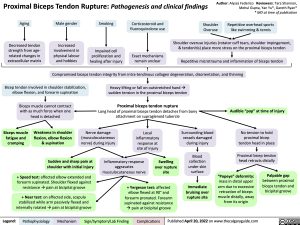Proximal Biceps Tendon Rupture: Pathogenesis and clinical findings
Author: Alyssa Federico Reviewers: Tara Shannon, Mehul Gupta, Yan Yu*, Gareth Ryan* * MD at time of publication
Aging
Decreased tendon strength from age- related changes in extracellular matrix
Male gender
Smoking
Corticosteroid and fluoroquinolone use
Shoulder Overuse
Repetitive overhead sports like swimming & tennis
Shoulder overuse injuries (rotator cuff tears, shoulder impingement, & tendonitis) place more stress on the proximal biceps tendon
Repetitive microtrauma and inflammation of biceps tendon Compromised biceps tendon integrity from intra-tendinous collagen degeneration, disorientation, and thinning
Increased involvement in physical labour and hobbies
Impaired cell proliferation and healing after injury
Exact mechanisms remain unclear
Bicep tendon involved in shoulder stabilization, elbow flexion, and forearm supination
Biceps muscle cannot contract with as much force when one head is detached
Heavy lifting or fall on outstretched handà sudden tension in the proximal biceps tendon
Proximal biceps tendon rupture
Long head of proximal biceps tendon detaches from bony attachment on supraglenoid tubercle
Audible “pop” at time of injury
No tension to hold proximal bicep tendon head in place
Proximal bicep tendon head retracts distally
Biceps muscle fatigue and cramping
Weakness in shoulder flexion, elbow flexion & supination
Nerve damage (musculocutaneous nerve) during injury
Local inflammatory response at site of injury
Surrounding blood vessels damaged during injury
Blood collection under skin surface
Immediate bruising over rupture site
Sudden and sharp pain at shoulder with initial injury
Inflammatory response aggravates musculocutaneous nerve
Swelling over rupture site
+ Speed test: affected elbow extended and forearm supinated. Shoulder flexed against resistanceàpain at bicipital groove
+ Neer test: on affected side, scapula stabilized while arm passively flexed and internally rotatedàpain at bicipital groove
+ Yergeson test: affected elbow flexed at 90° and forearm pronated. Forearm supinated against resistance àpain at bicipital groove
“Popeye” deformity:
mass in distal upper arm due to excessive
retraction of biceps muscle distally, away from its origin
Palpable gap
between proximal biceps tendon and bicipital groove
Legend:
Pathophysiology
Mechanism
Sign/Symptom/Lab Finding
Complications
Published April 20, 2022 on www.thecalgaryguide.com

